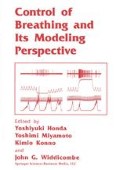Abstract
At rest, 9 millimoles per minute of acid equivalents in the form of CO2 are produced in a typical man. This rate increases to 45 mmol/min during moderate pace walking and up to 200 mmol/min during heavy exercise in a fit man. The primary mechanism by which an overwhelming body acidosis is avoided is by increasing alveolar ventilation (̇VA) in proportion to the metabolic rate. If ̇VA failed to excrete only 10% of metabolically produced CO2, the pH would fall by approximately 0.03 pH units per minute and the pH would decrease to approximately 7.1 after 10 min of walking. Since so many physiological functions depend on the pH of the perfusing blood, a well-designed ventilatory control system would take into account the acid load, including the rate of volatile (carbonic) and non-volatile (e. g. lactic) acid production.
Access this chapter
Tax calculation will be finalised at checkout
Purchases are for personal use only
Preview
Unable to display preview. Download preview PDF.
References
K. Wasserman and R. Casaburi, Acid-base regulation during exercise in humans, in: “Exercise-Pulmonary Physiology and Pathophysiology,” B.J. Whipp, ed., Marcel Dekker Inc. (1991).
M. Gleeson and J.H. Brackenbury, Effects of body temperature on ventilation, blood gases and acid-base balance in exercising fowl, Quart. J. of Exper. Physiol. 69:61–72 (1984).
W. Stringer, R. Casaburi and K. Wasserman, Acid-base regulation during exercise and recovery in man, J. Appl. Physiol. (In Press).
W.L. Beaver, K. Wasserman and B.J. Whipp, A new method for detecting the anaerobic threshold by gas exchange, J. Appl. Physiol. 60:2020–2027 (1986).
D.Y. Sue, K. Wasserman, R.B. Moricca and R. Casaburi, Metabolic acidosis during exercise in patients with chronic obstructive pulmonary disease, Chest 94:931–938 (1988).
R. Casaburi, J. Daly, J.E. Hansen and R.M. Effros, Abrupt changes in mixed venous blood gas composition after the onset of exercise, J. Appl. Physiol. 67:1106–1112 (1989).
W.L. Beaver, N. Lamarra and K. Wasserman, Breath-by-breath measurement of true alveolar gas exchange, J. Appl. Physiol. 51(6): 1662–1675 (1981).
C. Olsen, An enzymatic fluorometric micro method for determination of acetoacetate B-hydroxybutyrate, pyruvate and lactate, Clin. Chem. Acta 33:293–300 (1971).
O. Siggard-Andersen, The pH-log PCO2 blood acid-base nomogram revised, Scand. J. Clin. Lab. Invest. 14, 598–604 (1962).
H.G. Forster, L.G. Pan, G.E. Bisgard, R.P. Kaminski, S.M. Dorsey and MA. Busch, Hyperpnea of exercise at various PIO2 in normal and carotid body denervated ponies, J. Appl. Physiol. 54:1387–1393 (1983).
K. Wasserman, B.J. Whipp, R. Casaburi and W.L. Beaver, Carbon dioxide flow and exercise hyperpnea: Cause and effect? Am. Rev. Resp. Dis. 115:225–237 (1977).
L.B. Diamond, R. Casaburi, K. Wasserman and B.J. Whipp, Kinetics of gas exchange and ventilation in transitions from rest or prior exercise, J. Appl. Physiol. 43:704–708 (1977).
R. Casaburi, B.J. Whipp, W.L. Beaver, K. Wasserman and S. Koyal, Ventilatory and gas exchange dynamics in response to sinusoidal work, J. Appl. Physiol. 42:300–311 (1977).
D. Linnarsson, Dynamics of pulmonary gas exchange and heart rate changes at start and end of exercise, Acta Physiol. Scand. Suppi. 425:1–68 (1974).
K. Wasserman, A. Van Kessel and G.G. Burton, Interaction of physiological mechanisms during exercise, J. Appl. Physiol. 22:71–85 (1967).
R. Casaburi, T.J. Barstow, T. Robinson and K. Wasserman, Influence of work rate on ventilatory and gas exchange kinetics, J. Appl. Physiol. 67:547–555 (1989).
Author information
Authors and Affiliations
Editor information
Editors and Affiliations
Rights and permissions
Copyright information
© 1992 Springer Science+Business Media New York
About this chapter
Cite this chapter
Wasserman, K., Stringer, W., Casaburi, R. (1992). Acid-Base Regulation and Ventilatory Control during Exercise and Recovery in Man. In: Honda, Y., Miyamoto, Y., Konno, K., Widdicombe, J.G. (eds) Control of Breathing and Its Modeling Perspective. Springer, Boston, MA. https://doi.org/10.1007/978-1-4757-9847-0_73
Download citation
DOI: https://doi.org/10.1007/978-1-4757-9847-0_73
Publisher Name: Springer, Boston, MA
Print ISBN: 978-1-4757-9849-4
Online ISBN: 978-1-4757-9847-0
eBook Packages: Springer Book Archive

